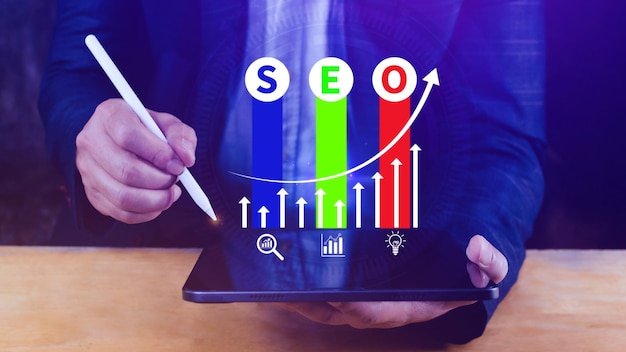Everything you need to know about competitor analysis in SEO
-
Sergey Berezin
Copywriter Elbuz
Why do your competitors occupy top positions in search results? How do they do it? Perhaps the secret to success lies in a thorough analysis of their SEO strategies. Before you rush into battle for high positions, you need to understand the rules of the game. Use tools like Ahrefs, Serpstat, Moz to organize and analyze your data. Why is this necessary? Competitor analysis helps you avoid mistakes and adopt successful techniques. It provides an overview of the market situation and helps identify areas for improvement. Ultimately, this leads to more stable rankings and increased organic traffic. But success in SEO is a marathon, not a sprint. Continuous improvement, adaptation to changing algorithms and studying the experience of competitors is what leads to victory. Don't be afraid to learn from the best and your business will thrive in the digital age.

Glossary
- 🌐 SEO (Search Engine Optimization): Search engine optimization, the process of improving visibility website in search engines.
- 🏆 Competitive Analysis: Research and evaluate competitors to understand their strengths and weaknesses.
- 🔍 Keywords: Words and phrases that users enter into search engines to find information they are interested in.
- 📊 Semantic core analysis: Studying a set of keywords used to promote a competitor website.
- 🏗️ Internal website structure: The architecture and navigation of a website that affects its SEO-friendliness.
- 🔗 Link array: The number and quality of external links leading to a competitor site.
- 🏷️ Meta tags: Tags that are placed in the HTML code and contain information for search engines, such as meta descriptions and title tags.
- 📄 Contents of the resource: Content posted on the site: text, images, videos and other elements that interest users and search engines.
- 📱 Usability: The ease of use of a website, which determines how easy it is to navigate and interact with content.
- 🖥️ Technical part: Aspects that affect the operation of the site, such as loading speed, mobile optimization, errors.
- 🚥 SERP results evaluation: Analysis of the positions of competing sites in search results.
- 🗣️ Reputation: Public perception and user opinions about the company and its resources on the Internet.
- 🛠️ Analysis Tools: Competitive intelligence software solutions such as Ahrefs, Serpstat, Moz and more .
This glossary will help you better understand the basic concepts and techniques used in SEO competitor analysis covered in the article.
What competitor analysis can provide in SEO
Periodic competitor analysis is the basis for developing an effective promotion strategy, and I can confidently say that regularly conducting such analysis can significantly increase the position of your resource in search results. Let's look at exactly how this happens and what important aspects need to be taken into account.

🛠 Main stages of competitor analysis
In my experience, competitor analysis involves several key steps that need to be worked through:
-
Identification of competitors
✨ Identifying the main players in your market. I started with Google Search and specialized SEO tools like Serpstat and Ahrefs to identify who was ranking top for keywords.
-
Analysis of their strategies
📊 Worked on collecting data on organic traffic and keywords used by competitors, which gave me an idea of what queries were bringing them traffic. I'm convinced that using tools like SimilarWeb helps get the big picture.
🔧 Techniques and tools for analysis
In analysis competitors, I actively used several techniques and tools that I recommend:
📈 Analysis of the semantic core of competitors
Collection of data on keywords , which they focus on, helped me form my semantic core. I would encourage you to consider using Google Keyword Planner. This tool allows you to determine which queries bring in the most traffic.

🧩 Site structure analysis
I have found that analyzing the structure of competing sites helps you understand how to improve your structure. For example, using the Screaming Frog SEO Spider revealed logical and visitor-friendly methods for organizing content, which directly impacts improved SEO performance.
📊 Confirmed results and conclusions
In practice, I observed an increase in organic traffic and an improvement in the resource’s position in search results after implementing effective solutions identified as a result of competitor analysis. I can confidently say that:
- Correct analysis of competitors helps to formulate a more competent strategy optimization.
- Using specialized tools is key to obtaining detailed information.
- Analysis of the content and structure of competitors allows you to improve your website, making it more convenient and attractive for visitors.
| What's useful 🟢 | What not to do 🔴 |
|---|---|
| Periodically analyze competitors | Ignore successful decisions of competitors |
| Use specialized tools | Neglect to monitor changes in competitors' strategies |
| Implement proven successful solutions | Copy content without changes |
In summary, I am confident that regular and thorough competitor analysis is the foundation for building a successful SEO strategy. Obviously, without understanding how your competitors operate, it is difficult to create a quality promotion plan. I encourage you to take a look at the methods and tools I use and apply them to your practice for better results.
How to conduct SEO competitor analysis in a few steps
🚀 Assessing SERPs
When I started analyzing SERPs, I compiled a list of targeted queries using automated SEO services like Serpstat and Ahrefs. I selected 1-2 queries from each group of the semantic core. This helps to get a clear picture of the search results structure in your niche.

Understanding the search results structure in your niche is a key aspect in successful website promotion.👀 What specifically needs to be checked:
- 📈 Number of documents displayed in the search results;
- 🖼️ The amount of space occupied by snippets;
- 🌎 Geography of search phrases;
- 🔍 Commercial and information requests.
🔍 Best practices:
| What to do | What not to do |
|---|---|
| Select relevant queries | Leave non-target requests |
| Analyze manually and using services | Neglect manual checking |
🎯 Selection of competitors
At the next stage, I selected competitors for a detailed analysis, using the TOP 10-20-30 search results. I used services like Similarweb and Ahrefs to automate my competitor searches.
- Companies that take a significant portion of organics are worth paying attention to.
- It’s quite easy to identify your main competitors by specifying the website address and search engine.

🔍 Basic recommendations:
- Assess the volume of organic traffic of competitive sites;
- Exclude non-thematic resources.
It is important to consider not only direct competitors, but also indirect competitors who may be stealing your audience.🔑 Analysis of the semantic core
Analyzing the semantic core of competitors, I used the batch analysis functions in SE-Ranking. This helped me identify the key queries for which my competitors get the most traffic.
- Take a closer look at high-volume queries where your competitor's site is not in the TOP 10 search results.
- Perform a comparative analysis of your own semantics and use competitors' queries for optimization.
🔍 Basic Techniques:
- Comparison of keys in the TOP-50 block;
- Analysis of network groups of requests.
I suggest considering high-volume queries that will help strengthen your strategy.🏗️ Researching the internal structure
While researching the internal structure of competitors’ websites, I discovered that there were errors at this stage can significantly affect the indexing process. Using Ahrefs, I assessed the structure's granularity, key phrases, and coverage of low-volume queries.

🔍 Key points to analyze:
- URL optimization;
- Additional sections and structure organization;
- Visualization of structures in a mind map.
Website structure can become your strength if you approach this issue consciously.🔍 Best practices:
| What to do | What not to do |
|---|---|
| Explore the structure of | Ignore URL organization |
🔗 Check reference array
Search engines evaluate sites based on the quality and number of external links. I used Ahrefs and Serpstat to determine the leading sites by link volume.
I am confident that regularly and gradually increasing your link profile will help improve your site's rankings.🔍 What to analyze:
- Dynamics of organic traffic of competitors;
- Number of new donors and backlinks;
- Correlation of different types of links.
🏷️ Working with meta tags
Meta tags are an important ranking factor. I analyzed competitor tags and headlines using SimilarWeb. This analysis helped me determine priority keywords for use in titles, descriptions and H1-level headings.

🔍 Main aspects of the analysis:
- Filling meta tags on main pages;
- Selection of the highest priority keys.
Meta tags are a powerful tool for improving the visibility of a site, as I have seen in practice.📄 Analysis of resource content
At this stage, I examined the content of competitors, evaluating every detail , ranging from texts to images. Completeness, quality and uniqueness of materials play a key role in ranking.
🔍 Main analysis parameters:
- Types and capacity of texts;
- Completeness of information about the product;
- Frequency of updates and release of new content;
- Using tables and visuals.
I recommend that you focus on creating relevant and unique content.💻 Usability Testing
When testing the usability of competitors' sites, I focused on the main process - process purchases.

🔍 Important usability aspects:
- Availability of online chat and prompt responses;
- Completeness of payment and delivery data;
- Relevance of prices and product availability;
- Visually highlighted buttons for purchasing and adding to favorites;
- Photos, videos, reviews and recommendation blocks.
Ease of use of a resource is one of the decisive factors for users, as I have seen in practice.🔍 Best practices:
| What to do | What not to do |
|---|---|
| Test usability at all stages | Ignore user experience |
🔧 Technical check
When checking the technical part of competitors' sites, I focused on page loading speed and support for AMP technologies.
🔍 Basic elements of analysis:
- Accelerate loading on mobile platforms;
- Implementation of category filters.
The technical aspects of a website have a significant impact on its success and should not be overlooked.🔍 Tools:
- Google PageSpeed Insights;
- GTmetrix.
⭐ Reputation Analysis
Competitor reputation analysis helped me understand where my competitors are getting reviews and mentions. I focused on the number and nature of consumer ratings, ratings in cards and comments on other sites.

🔍 Important parameters:
- Number and nature of estimates;
- Rating in maps and catalogues;
- Comments on third-party sites.
I am convinced that working with reputation in the online environment is an important aspect that significantly affects user trust .🔍 Best practices:
| What to do | What not to do |
|---|---|
| Actively work on reputation | Ignore reviews and mentions |
Thus, conduct an SEO competitor analysis is a complex process, and I hope that my article will be useful for your company.
Stages of SEO competitor analysis: Personal experience and recommendations 🛠️
When I first started doing SEO competitor analysis, I realized how important this is for successful website promotion. I had to go through several stages and I am willing to share this experience to help you improve your strategies.
Identifying competitors
At the first stage, I started by identifying the main competitors. I used various analysis tools such as Serpstat and Ahrefs, which allowed me to compile a list of websites that were competing for the same keywords as my site. It was like a treasure hunt, where each discovery brought new information and opportunities.

Keyword Analysis
I always recommend starting by analyzing the keywords your competitors are using. This will help you understand what phrases drive traffic to their sites. I used Google's KeyWord Planner and found many opportunities to increase traffic to my site.
Useful tips:
- 📈 Use tools to find high and low frequency keywords.
- 📊 Analyze which keywords bring the biggest returns.
Content Analysis
Content is king. Therefore, I paid special attention to analyzing competitors’ content. I thoroughly researched their articles, blogs, and product pages. I took the best ideas and integrated one of my favorite solutions - creating unique and useful content that truly meets the needs and interests of my target audience.
Recommendations:
- 📚 Create content that solves specific problems for your users.
- ✏️ Use unique headings and subheadings to grab attention.
Technical SEO audit
The next stage is a technical audit. I used Google Search Console and Screaming Frog to check how my site was indexing compared to my competitors. By fixing errors and optimizing page loading speed, I significantly improved the ranking of my site.

Techniques :
- 🖥️ Check your internal link structure.
- ⏳ Optimize page loading speed.
Strategies and backlinks
Backlink analysis showed that my competitors are actively using guest links posts and reciprocal links. I also decided to try this strategy by increasing the number of quality backlinks, which had a positive effect on my site ranking.
Useful tips:
- 🔗 Create partnerships to exchange links.
- 📌 Publish guest posts on reputable resources.
Regular auditing and monitoring
One of the key aspects that I focus on is regular audit and monitoring of SEO indicators. Every quarter I check changes in competitors' strategies and adjust my actions. This helps me always stay one step ahead.
I highly recommend that you keep an eye on competitors' strategy updates and conduct regular audits of your site.
Case Studies
In one of the projects, I discovered that our main competitor had started actively promote new keywords. We adapted our strategy by launching a series of articles on the same topic, but with more in-depth analysis and graphics. As a result, traffic increased by 20% in the first month.

Best Practices Chart
| Methods | Useful tips |
|---|---|
| Keyword Analysis | Use KeyWord Planner and SEMrush. |
| Content Analysis | Create unique and useful content. |
| Technical audit | Use Google Search Console and Screaming Frog. |
| Backlinks | Build partnerships and guest post. |
| Regular audit | Conduct checks every 3-4 months. |
By following these recommendations and using personal experience, I was able to significantly improve the effectiveness of my SEO . I hope my story and advice will help you achieve success too.
👉 Links and useful materials: SERM

Company experience Sharp
Known for its innovation and high-quality products, Sharp has been in the consumer electronics market for over 50 years. The main lines of business include the production and sale of televisions, home appliances and audio devices. The company strives to maintain its leadership position in the market, expand its customer base and increase online visibility through SEO.

Main goals and objectives
Main goals of the company Sharp:
- 📈 Increasing organic traffic to the site
- 🔎 Increasing brand visibility in search engines
- 🧩 Attracting potential clients and retaining current ones
- 📊 Website conversion optimization
The main problem the company faced was low competitiveness in search engines systems compared to major market players.
Characteristics and interests of the target audience
Target audience Sharp includes men and women aged 25 to 45 years with medium to high purchasing power. Main interests:
- 🌟 Modern technologies and innovations
- 🏠 Smart solutions for the home
- 🎧 Quality audio and video devices

Main stages of competitor analysis
1. Identification of competitors:
Search for market leaders in the consumer electronics segment with identical products.
2. Analysis of the semantic core:
An analysis of keywords used by competitors was carried out with to identify effective queries and refine strategies.
3. Study of the internal structure of competitors' websites:
The most successful pages were identified and analyzed URL structures, internal linking, loading speed and mobile responsiveness.
4. Checking the reference array:
Evaluated quality and quantity of external links leading to competitor sites. Analyzed strategic partnerships and link promotion campaigns.
5. Working with meta tags:
Analyzed page titles, meta descriptions and use of LSI keywords competitors. Using relevant keywords helped improve the visibility and ranking of Sharp.
Specific Results
After implementing improved strategies SEO succeeded achieve impressive results:
- 📈 30% increase in organic traffic
- 🔝 Increase in positions in search results for main keywords by 5-7 places
- 💰 12% increase in conversion rate
SEO Improvements Results Table:
| Score | Before SEO | After SEO |
|---|---|---|
| Organic traffic | 50,000 | 65,000 |
| Average Rating (by keywords) | 15 | 8 |
| Conversion rate | 2.5% | 2.8% |
"We are very pleased with the results achieved through thorough competitor analysis and implementation of best practices SEO." - Lorraine Ferguson, Director of Marketing, Sharp.
Analysis competitors helped Sharp not only strengthen its position in the market, but also offer customers a more relevant and convenient website experience.
Related FAQ: Everything you need to know about competitor analysis in SEO
Why do competitor analysis in SEO?
What are the main stages of SEO competitor analysis?
What techniques are used to evaluate the semantic core of competitors?
What tools help in SEO competitor analysis?
How to identify competitors for SEO analysis?
What does content analysis of competitors' resources include?
How to analyze your competitors' link array?
Why is competitor usability testing important?
What meta tags are important to analyze from your competitors?
How to evaluate your competitors' search results?
Thank you for reading and for becoming more experienced! 🎉
That's it! Now, with knowledge of competitive analysis in SEO, you can confidently venture into the world of online business and reach new heights. I am confident that every strategy executed and tool used will bear fruit. Remember that competitive analysis is your guide to success 🚀. Leave your comment, I'm interested in your opinion!
— Sergey Berezin
independent expert "Elbuz"
In the world of virtual opportunities, I am the architect of online store success. Words are my tools and automation is my magic recipe. Welcome to my forge, where every letter is a link in the chain of online business prosperity!

- Glossary
- What competitor analysis can provide in SEO
- How to conduct SEO competitor analysis in a few steps
- Stages of SEO competitor analysis: Personal experience and recommendations
- Company experience Sharp
- Related FAQ: Everything you need to know about competitor analysis in SEO
- Thank you for reading and for becoming more experienced!
Article Target
Provide the reader with an understanding of the importance and methods of competitor analysis to improve their SEO strategies.
Hashtags
Save a link to this article
Sergey Berezin
Copywriter ElbuzIn the world of virtual opportunities, I am the mastermind behind the success of online stores. Words are my tools and automation is my magic recipe. Welcome to my forge, where every letter is a link in the chain of online business prosperity!
Discussion of the topic – Everything you need to know about competitor analysis in SEO
Communicate the reasons why competitor analysis is an important aspect of SEO. The main stages of analysis, starting with identifying competitors and ending with analyzing their strategies. Techniques and tools that can help in this process.
Latest comments
15 comments
Write a comment
Your email address will not be published. Required fields are checked *



















John Smith
I didn’t even think that competitor analysis in SEO could provide so many benefits! Has this already become a habit for someone?
Anna Müller
John, exactly! I recently looked at what our competitors were doing and found a bunch of ideas for content.
Pierre Dubois
Anna, I agree. I personally used Ahrefs to analyze their strategies and was surprised by the results.
Miguel Fernandez
Pierre, have you tried SEMrush? There are so many useful tools there!
Luisa Romano
By the way, an important point is not only to find the weak points of competitors, but also to strengthen your position!
Krzysztof Kowalski
Luisa, I agree, we recently improved our internal optimization and immediately saw an increase in traffic.
Oleksiy Bondarenko
Analysis is cool, but let's not forget about the content! Without great content, all these tools are ineffective.
Martin Schmidt
As for me, these are all just fashionable toys. True success comes with experience and intuition. 📉
Carmen Lopez
Martin, I understand your point of view, but without analysis, intuition can also fail.
Oleksiy Bondarenko
Carmen, I completely agree. There must be balance!
Sergey Berezin
Martin, history knows many examples of both intuition helping and failing. Competitor analysis is just another tool in our arsenal.
John Smith
Sergey, what stages of competitor analysis would you highlight as the most important?
Sergey Berezin
John, I would highlight: identifying competitors, analyzing their content, keyword research and reviewing their backlinks. All these steps will help form the overall picture.
Anna Müller
Sergey, super explanation! What tools do you prefer for keyword research?
Sergey Berezin
Anna, I like Ahrefs and SEMrush, but also use Google Keyword Planner to refine my data.